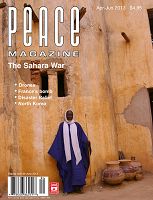
Peace Magazine Apr-Jun 2013, page 29. Some rights reserved.
Search for other articles by Paul Dekar here
By Joanna Santa Barbara, Johan Galtung and Diane Perlman. Transcend University Press, 2012.
This book presents basic ideas intended to be applicable to all geographical areas, all cultures, and all social space for conflict at any level: interpersonal, intercultural, or international. Drawing on experience working for peace, health, and trauma healing, the authors observe that reconciliation work is peace work directed at building towards cultures of peace. They seek to show how (pp. 8-9).
The authors begin with a definition of peace as a harmonious relationship in which conflicts are resolved non-violently. Concerned with situations in which peace has been broken, harm or violence has occurred, and equity is unbalanced, they define reconciliation as the creation or restoration of peace in a relationship. For a relationship to become peaceful, healing of various kinds must occur, balance must be restored and moral debts must be closed. Then, all involved can deal constructively with the present and the future, together or separately (p. 11).
In Part I, Exploring Reconciliation, Joanna Santa Barbara explores key elements and dilemmas of reconciliation. She offers eleven case studies, including Maori-Pakeha reconciliation in New Zealand, where she actively seeks healing of earth through participating in developing an eco-village based on permaculture principles (”$“http://atamai.co.nz/).
In Part II, A Transcend Reconciliation Approach, Johan Galtung presents a theory that draws from practical engagement over his career. Galtung first explores intention. He asks to what extent the harm intended is willed. He then considers the whys and wherefores of identifying targets. Does the victim’s identity matter to the perpetrator, or is the harm inflicted entirely random? Finally, he asks to what extent the harm is irreversible.
In Part III, The Future of Reconciliation, the three authors take up specific themes: structural-cultural violence; multitrack reconciliation; training and socialization; gender issues; and the question: “If it does not work, what then?”
A case in this reviewer’s consciousness, the massacre at Sandy Hook Elementary School, which presents not only the people of Newtown, Connecticut, but all of us with the question: how can conciliation close the worst aspects of the immediate past and open a path to the future, making it livable? For therapist Judith Herman, restoration of social bonds that have been broken begins with this affirmation: we are not alone. (Trauma and Recovery, New York: Basic, 1997, p. 236).
We are social beings. Relationship repair and reconciliation are never ending tasks. Santa Barbara, Galtung and Perlman call on humans to live compassionately, to seek justice, and to build a common future. Due to climate change, energy scarcity, and financial strains, these tasks are all the more crucial as we move through the 21st century.
Bringing together theory and praxis, the authors present a compelling book that deserves wide readership. The authors succeed in providing tools. Basic conclusions include:
I share many concerns and commitments of the authors, including the importance of conflict transformation and the spiritual aspects of conflict. I am less sanguine in agreeing (p. 193) with the thesis of Steven Pinker that the world has become less violent in the last half century (The Better Angels of Our Nature: The Decline of Violence in History and its Causes, 2011).
A resource for a university class, a spiritual community or a neighborhood group, this book does not pretend to exhaust the subject. Its conclusion is to offer a compelling set of recommendations:
Build peace education, including reconciliation, into every child’s rearing and education. Ensure access in communities to people with expertise in reconciliation. While respecting timing issues in reconciliation, begin processes as soon as appropriate after wrongs have been done. Draw from a wide repertoire of ways of reconciling, and respect the commonality of elements that seem to make up successful reconciliation processes. Accept that some reconciliation processes may take generations to accomplish. In society-wide reconciliation there may be a role for each person.” (p. 194)
I have taught courses on reconciliation. I would assign this book as a text. Other titles on the subject rarely discuss key themes in this book, notably chapter four (reconciliation with the earth), chapter nine (reconciliation with death) and chapter fourteen (gender and reconciliation). Excellent audio visual resource materials are available such as the film Fambul Tok, which describes the rehabilitation of former child soldiers in Sierra Leone from 2002-3 (pp. 87-88).
I would continue to assign Simon Wiesenthal’s The Sunflower (1997). Noted for his work in identifying Nazi war criminals, Wiesenthal recounts his imprisonment in a Nazi death camp. One day he was taken to the bedside of a dying member of the SS. Haunted by the crimes in which he had participated, the soldier wanted to confess to—and obtain absolution from—a Jew. Faced with the choice between compassion and justice, silence and truth, revenge and reconciliation, Wiesenthal asks readers: What would you do?
Paul Dekar writes, teaches and works with peace groups. He lives in Dundas, Ontario.

Peace Magazine Apr-Jun 2013, page 29. Some rights reserved.
Search for other articles by Paul Dekar here